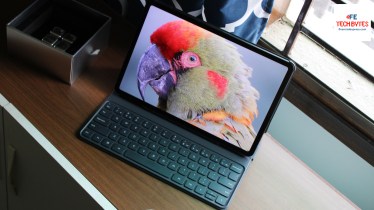For Xiaomi, bigger is better. Or at least, that is the impression you get from its latest midrange tablet in India. This tablet is not a flagship “Xiaomi” tablet. Rather, it falls under Redmi, the banner known for value-centric devices that have often punched above their weight class, which makes reviewing them a bit more fun and exciting to be honest. The same is true about the new Redmi Pad Pro as well.
This is the first time Xiaomi has launched a tablet in India in both Wi-Fi and cellular options at the same time. Moreover, it’s offering 5G. Even the Mi Pad 6—which is technically a more superior tablet—doesn’t do that. When it comes to making forward-facing technology accessible, the Redmi Pad Pro lives up to Redmi’s storied history giving the tablet a great head start over every other competing tablet in its price range today.
The pricing is really the biggest draw. A version with 8GB of RAM and 128GB of storage costs Rs 24,999. You’ll pay Rs 26,999 for getting double the storage. The Wi-Fi only variant is obviously going to be cheaper—Rs 21,999 for 6GB/128GB. It is easy to look past any minor discrepancies in hardware at these prices. The thing is, a few days in with the Redmi Pad Pro, I haven’t found anything that would keep me from recommending it. Xiaomi seems to have put everything you might need.
| Price | |
| Redmi Pad Pro Wi-Fi | Rs 21,999 (6GB/128GB) |
| Redmi Pad Pro 5G | Rs 24,999 (8GB/128GB), Rs 26,999 (8GB/256GB) |
| Redmi Smart Pen | Rs 3,999 |
| Redmi Pad Pro keyboard | Rs 3,999 |
| Redmi Pad Pro cover | Rs 1,499 |
The screen is big, measuring 12.1-inch diagonally. This is in fact the biggest tablet that Xiaomi currently sells in the country. The Redmi Pad for reference is 10.61-inch. The Xiaomi Pad 6 gets close at 11-inch, but it’s still quite not there yet by a good margin. However, it has a higher resolution and a faster refresh rate justifying its flagship stature. Next to the Redmi Pad, the update is noticeable: 2560x1600p versus 2000×1200 and 120Hz versus 90Hz. The panel in the Redmi Pad Pro is also “adaptive” so it can smartly pipe down to something as low as 30Hz when need be. The idea is to save battery life wherever you can.
Battery life isn’t going to be a big problem for it though. Xiaomi has packed a ginormous 10,000mAh battery inside it and while I’m yet to fully test its potential, Xiaomi clearly has the big number advantage. Plus, realistically speaking, too, Xiaomi devices tend to eke out more from the available capacity even if sometimes, the company’s aggressive methods could be tad frustrating for end-users. (They tend to pull some of these antics also to avoid overheating.) Xiaomi isn’t chasing any big numbers when it comes to fast charging for some reason. The Redmi Pad Pro tops out at 33W. A compliant charger ships in the box.
It’s not at all surprising that the Redmi Pad Pro weighs what it does—more than half a kg (~570g). The OnePlus Pad 2, another 12.1-inch tablet, weighs even more. It’s not an apples to apples comparison, only a reminder, that these are not smartphones. If you want something lighter, get a smaller tablet.
The build quality of the Redmi Pad Pro feels right even if I am not too fond of the design. The colour choices are run-of-the-mill, all-metal silver and gray. To my eyes, the Xiaomi Pad 6 has more character. This one looks just okay. Like the Pad 6, this one also leads you to believe it has multiple cameras on the back, god knows why. There is only one camera. I believe it’s the same 8-megapixel from the Redmi Pad. The front camera—another 8-megapixel—is also the same. The product listing confirms it has Corning Gorilla Glass 3 for screen protection.
Powering the Redmi Pad Pro is a Qualcomm Snapdragon 7s Gen 2. In a commendable move, both the Wi-Fi and 5G options have the same chip. Both versions run Xiaomi’s HyperOS with Android 14 and are guaranteed to get three years of major OS and four years of security updates (up from the Redmi Pad’s 2+3). It is launching a new interconnectivity app alongside that lets you do a whole bunch of things like view and interact with the home screens of nearby Xiaomi phones, paste text and images to them after copying them on the tablet and more. Your usual suspects like multiple windows are available as well.
Rounding off the package are quad speakers and headphone back, dual SIM 5G, storage expansion, Wi-Fi 6E, and Bluetooth 5.2. Watch this space for our full Redmi Pad Pro review coming soon.
